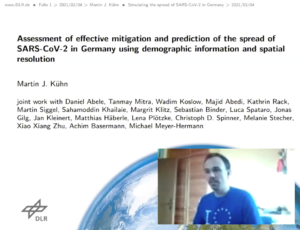Assessment of effective mitigation and prediction of the spread of SARS-CoV-2 (Seminar Talk)
Assessment of effective mitigation and prediction of the spread of SARS-CoV-2 in Germany using demographic information and spatial resolution
 Non-pharmaceutical interventions (NPIs) are important to mitigate the spread of infectious diseases as long as no vaccination or outstanding medical treatments are available. We assess the effectiveness of the sets of non-pharmaceutical interventions that were in place during the course of the Coronavirus disease 2019 (Covid-19) pandemic in Germany [5]. Our results are based on hybrid models, combining recent SIRtype [4] models on local scales with spatial resolution. In order to account for the age-dependence of the severe acute respiratory syndrome coronavirus 2 (SARS-CoV-2), we include realistic prepandemic and recently recorded contact patterns between age groups [6, 2, 7, 3]. The implementation of non-pharmaceutical interventions will occur on changed contact patterns, improved isolation, or reduced infectiousness when, e.g., wearing masks. In order to account for spatial heterogeneity, we use a graph approach and we include high-quality information on commuting activities [1] combined with traveling information from social networks. The remaining uncertainty will be accounted for by a large number of randomized simulation runs. Based on the derived factors for the effectiveness of different non-pharmaceutical interventions over the past months, we provide different forecast scenarios for the upcoming time.
Non-pharmaceutical interventions (NPIs) are important to mitigate the spread of infectious diseases as long as no vaccination or outstanding medical treatments are available. We assess the effectiveness of the sets of non-pharmaceutical interventions that were in place during the course of the Coronavirus disease 2019 (Covid-19) pandemic in Germany [5]. Our results are based on hybrid models, combining recent SIRtype [4] models on local scales with spatial resolution. In order to account for the age-dependence of the severe acute respiratory syndrome coronavirus 2 (SARS-CoV-2), we include realistic prepandemic and recently recorded contact patterns between age groups [6, 2, 7, 3]. The implementation of non-pharmaceutical interventions will occur on changed contact patterns, improved isolation, or reduced infectiousness when, e.g., wearing masks. In order to account for spatial heterogeneity, we use a graph approach and we include high-quality information on commuting activities [1] combined with traveling information from social networks. The remaining uncertainty will be accounted for by a large number of randomized simulation runs. Based on the derived factors for the effectiveness of different non-pharmaceutical interventions over the past months, we provide different forecast scenarios for the upcoming time.
Download Seminar-Talk Video: Seminar Talk
Link to preprint: medRXiv
References:
- BMAS. Pendlerverflechtungen der sozialversicherungspflichtig Beschäftigten nach Kreisen – Deutschland
(Jahreszahlen), 2019. - Laura Fumanelli, Marco Ajelli, Piero Manfredi, Alessandro Vespignani, and Stefano Merler. Inferring the
structure of social contacts from demographic data in the analysis of infectious diseases spread. PLoS
Computational Biology, 8(9):e1002673, 2012. - Christopher I. Jarvis, Kevin Van Zandvoort, Amy Gimma, et al. Quantifying the impact of physical distance
measures on the transmission of COVID-19 in the UK. BMC Medicine, 18(1):124, May 2020. - Sahamoddin Khailaie, Tanmay Mitra, Arnab Bandyopadhyay, Marta Schips, Pietro Mascheroni, Patrizio
Vanella, Berit Lange, Sebastian Binder, and Michael Meyer-Hermann. Development of the reproduction
number from coronavirus SARS-CoV-2 case data in Germany and implications for political measures.
medRxiv, page 2020.04.04.20053637, June 2020. - Martin J. Kühn, Daniel Abele, Tanmay Mitra, Wadim Koslow, Majid Abedi, Kathrin Rack, Martin Siggel,
Sahamoddin Khailaie, Margrit Klitz, Sebastian Binder, Luca Spataro, Jonas Gilg, Jan Kleinert, Matthias
Häberle, Lena Plötzke, Christoph D. Spinner, Melanie Stecher, Xiao Xiang Zhu, Achim Basermann, and
Michael Meyer-Hermann. Assessment of effective mitigation and prediction of the spread of sars-cov-2 in
germany using demographic information and spatial resolution. medRxiv, 2020. - Joël Mossong, Niel Hens, Mark Jit, Philippe Beutels, et al. Social Contacts and Mixing Patterns Relevant to
the Spread of Infectious Diseases. PLOS Medicine, 5(3):e74, March 2008. - Kiesha Prem, Alex R. Cook, and Mark Jit. Projecting social contact matrices in 152 countries using contact
surveys and demographic data. PLoS computational biology, 13(9):e1005697, September 2017.
